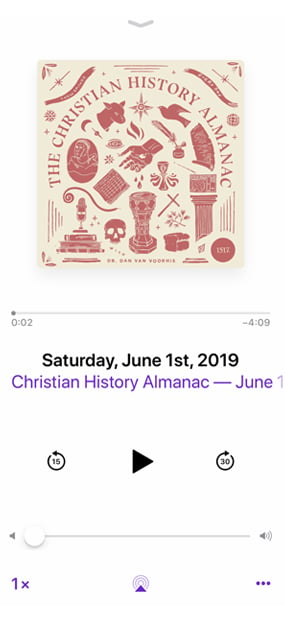Thursday, May 22, 2025
Today on the Christian History Almanac, we have a few events in the critical 4th century for the future of the church.
It is the 22nd of May 2025. Welcome to the Christian History Almanac, brought to you by 1517 at 1517.org; I’m Dan van Voorhis.
Today’s date pulls together two different events in the 4th century in the Christian church- one familiar, one not so much, and by looking at them in conjunction, it will allow us to zoom out and zoom in during this epoch-making century of Church history.
This first event, surrounding a character we’ve discussed on this show before, is the death of the Emperor Constantine on this day in 337. There might not be a more significant and complicated character in the early church.
Did he “make Christianity the official religion of the Empire”? No, but he legalized it.
Was he himself a Christian, or did he support the church “just in case”? Yes, I’ve told the story about how he wasn’t baptized initially and that he seems to have had an on-again, off-again relationship with the church. But he undoubtedly changed the trajectory of church history by realizing the need for a singular confession on the person and work of Jesus. By calling the Council of Nicaea and supporting the Creed that came out of it Constantine deserves a good bit of credit as an architect of the early church.
BUT- it was not as if the council and creed from Nicaea were instantly and universally adopted. It wasn’t even the case in Constantine’s own family.
After he died on this day in 337, the empire was divided between Constantine’s three sons. One, Constantine was a supporter of Nicene Christology, while another Constantius supported the opponents of Nicaea, and the third, Julian, is depicted as an opportunist who could support either.
And as these three sons played havoc with church unity by calling local councils and banishing bishops, there were others attempting to replace the Nicene Creed with creeds with compromising language on the person of Christ (that is, how he is both God and man). These included the Dedication Creed, the Western Creed, and the Long Lined Creed.
But none were as popular and infamous then the so-called “Dated” Creed- also called the Second Creed of Sirmium (boring) or the “Blasphemy of Sirmium” (intriguing) it got the name “the dated” creed because it stated in its prologue that it was created on this, the 22nd of May in 359 which was the eve of Pentecost.
The Creed avoided the language of Homoousian and Homoiousian- these words meaning one in essence, or alike in essence had been at the heart of the earlier debates trying to decide in what way the son was like the father. The criticism of the arian, or semi-arian position was that it subordinated the son to the father- it said “there was a time when the son was not” or “whatever the father is, the son is not the same, but similar”. To modern ears, this might seem obscure, but the early church needed to defend the deity of Christ- he was not primarily a prophet or teacher or man but God of God. For the saving mission of God- to be both priest and sacrifice- a Jesus that is fully God, nothing less, was argued to be necessary.
The “dated” Creed of the 22nd of May 359, in attempting to quell controversy, only created more controversy by continuing to flood the mid-century with divergent texts from regional councils trying to use compromised language.
You could ask- with the death of Constantine (on this date in 337) and the proliferation of creeds like the “Blasphemy of Sirmium” (on this date in 359), how was it eventually settled? It was ironically the rise of the next emperor- Julian the Apostate who, you can imagine his relationship to the church by his name, lead to the church under perceived persecution again and they would rally behind Athanasius and the council of Alexandria and the Ecumenical Council at Constantinople in 381 and establishment of the Nicene Creed as we know it today. But it was a rocky path to a semblance of unity- it saw the death of Constantine the Great and the creation of ersatz creeds, like the “dated” creed or blasphemy of Sirmium- both on this day, the 22nd of May in the 4th century.
The Last word for today comes from the daily lectionary and the book of Proverbs, from the second chapter
My son, if you accept my words
and store up my commands within you,
turning your ear to wisdom
and applying your heart to understanding—
indeed, if you call out for insight
and cry aloud for understanding,
and if you look for it as for silver
and search for it as for hidden treasure,
then you will understand the fear of the Lord
and find the knowledge of God.
This has been the Christian History Almanac for the 22nd of May 2025, brought to you by 1517 at 1517.org.
The show is produced by a man who knows you could look for wisdom as for silver, and find your silver at the official Morgan Silver Dollar Company, now selling official US government Morgan Silver Dollars… he is Christopher Gillespie.
The show is written and read by a man immediately suspicious of any commercial that wants to either sell, or buy, or trade in precious metals… I’ve moved on to bills and bank accounts… I’m Dan van Voorhis.
You can catch us here every day- and remember that the rumors of grace, forgiveness, and the redemption of all things are true…. Everything is going to be ok.

Subscribe to the Christian History Almanac
Subscribe (it’s free!) in your favorite podcast app.